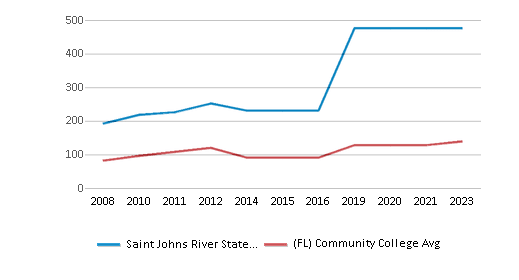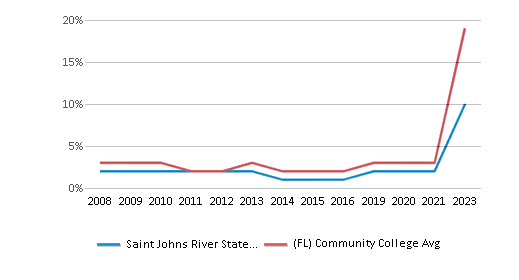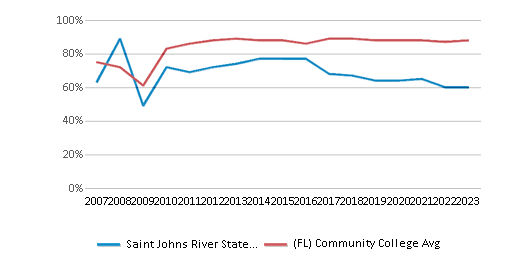- St. Johns River Community College is dedicated to providing students with equal access to a broad spectrum of educational and cultural opportunities while encouraging the pursuit of truth, academic excellence, and scholarly achievement. The College is committed to creating and continuously improving affordable, accessible, effective learning opportunities, resources, and support services for the ever-changing educational needs of the diverse population it serves.
School Highlights
Saint Johns River State College serves 8,433 students (32% of students are full-time).
The college's student:teacher ratio of 18:1 is lower than the state community college average of 20:1.
Minority enrollment is 36% of the student body (majority Hispanic), which is less than the state average of 67%.
Quick Stats (2025)
- Enrollment: 8,433 students
- In-state tuition: $2,998
- Out-state tuition: $10,668
- Student:teacher ratio: 18:1
- Minority enrollment: 36%
- Source: Integrated Postsecondary Education Data System (IPEDS)
Top Rankings
Saint Johns River State College ranks among the top 20% of public schools in Florida for:
Category
Attribute
Community Size
School Overview
The teacher population of 476 teachers has stayed relatively flat over five years.
Saint Johns River State College
(FL) Community College Avg.
Carnegie Classification
Baccalaureate/Associate's Colleges: Mixed Baccalaureate/Associate's
Not applicable, not in Carnegie universe (not accredited or nondegree-granting)
Institution Level
Four or more years
At least 2 but less than 4 years
Institution Control
Public
Private not-for-profit
Total Faculty
476 staff
139 staff

School Calendar
Student Body
The student population of Saint Johns River State College has grown by 14% over five years.
The student:teacher ratio of 18:1 has increased from 14:1 over five years.
The Saint Johns River State College diversity score of 0.56 is less than the state average of 0.76. The school's diversity has grown by 12% over five years.
Total Enrollment
8,433 students
646 students

Student : Teacher Ratio
18:1
20:1

# Full-Time Students
2,709 students
587 students

# Part-Time Students
5,724 students
557 students



# Enrollment Undergraduate
843 students
261 students
# Full-Time Undergraduate Students
2,709 students
574 students

# Full-Time Graduate Students
n/a
85 students
# Part-Time Undergraduate Students
5,724 students
648 students
# Part-Time Graduate Students
n/a
36 students
Total Dormitory Capacity
n/a
174 students
% American Indian/Alaskan
n/a
n/a

% Asian
3%
5%

% Hispanic
14%
30%

% Black
10%
19%

% White
64%
33%

% Hawaiian
n/a
2%

% Two or more races
5%
4%

% Non Resident races
n/a
2%
% Unknown races
4%
5%


Diversity Score
0.56
0.76

College Completion Rate (Students who graduate in less than 4 years)
35%
44%

College Completion Rate (Students who graduate in 4 years or more than 4 years)
0.4286%
0.4334%
Average Graduate Earnings (10 Years)
$33,800
$31,500

Tuition and Acceptance Rate
The public in-state tuition of $2,998 is less than the state average of $3,280. The in-state tuition has grown by 5% over four years.
The public out-state tuition of $10,668 is more than the state average of $10,578. The out-state tuition has stayed relatively flat over four years.
In-State Tuition Fees
$2,998
$3,280

Out-State Tuition Fees
$10,668
$10,578

% Students Receiving Some Financial Aid
60%
88%

Median Debt for Graduates
$12,375
$9,750

Median Debt for Dropouts
$7,026
$5,500

Acceptance Rate
n/a
94%
SAT Reading
n/a
442
SAT Math
n/a
429
ACT Composite
n/a
18
ACT English
n/a
18
ACT Math
n/a
18
Source: 2024 (or latest year available) Integrated Postsecondary Education Data System (IPEDS)
School Notes
- Florida School of the Arts, Florida's first state-supported professional arts school, was established in 1974 and is dedicated to the premise that intense, individualized instruction and practical "hands-on" experience are essential to the full development of a student's creative abilities. Florida School of the Arts or "FloArts," as referred to by students and local supporters, has a 600-seat auditorium, a studio theater and a fine art gallery. A print shop, dark room and state-of-the-art computer lab is also available to students. Enrollment is limited to 150 students. Admission to Florida School of the Arts is based on audition/portfolio review and an interview. FloArts is located on the Palatka Campus and is part of the academic and administrative structure of St. Johns River Community College. FloArts is statewide in scope, and has its own arts facility, faculty, administrative staff, mission statement, and curricula specific to each degree program. St. Johns River Community College is accredited by the Commission on Colleges of the Southern Association of Colleges and Schools to award the Associate Degree.
Frequently Asked Questions
How much does Saint Johns River State College cost?
Saint Johns River State College's tuition is approximately $2,998 for In-State students and $10,668 for Out-State students.
What is Saint Johns River State College's ranking?
Saint Johns River State College ranks among the top 20% of community college in Florida for: Largest student body.
Recent Articles

Obtaining Your Bachelor's Degree at a Community College
Explore the evolving landscape of community colleges offering bachelor's degrees, addressing affordability, accessibility, and workforce needs.

A to Z of Community College Certificates and Courses
From business and healthcare to technology and skilled trades, the article showcases the breadth of options available to students seeking to enhance their knowledge, develop new skills, or pursue career advancement.

What is a Community College?
This comprehensive guide explains what a community college is, its history, and its role in higher education. It covers the types of programs offered, differences from four-year colleges, benefits of attending, and important considerations for prospective students, providing valuable insights for those exploring educational options.






